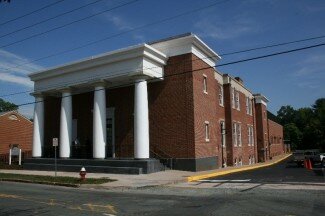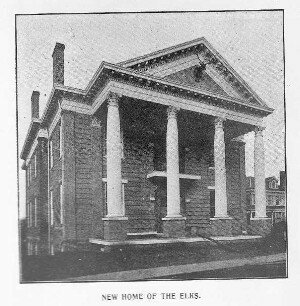All rise: New J&DR courthouse simpler, techier
 The former Elks Lodge turned courthouse gets a facial and a beefy new security system.
The former Elks Lodge turned courthouse gets a facial and a beefy new security system.PHOTO BY DAVE MCNAIR
It took five years and cost $20 million, but the newly renovated Juvenile & Domestic Relations Court building on High Street is finally open for business. Indeed, when the Hook visited last week, there was a full house in the lobby, buffered now by a shiny new metal detector and three bailiffs, while men in suits stood under the new portico having a smoke, and folks with a court date cursed and strategized with their lawyers.
Some have been alarmed at the time and cost of the renovation, which includes a three-level, 91-space parking deck and new office space, due in large part to the collapse of a section of the building in March 2006. A year after the collapse, City Attorney Craig Brown was still in discussions with the contractor, Kenbridge Construction, which he said revolved around the considerable cost of restoring the building and continuing the renovation.
Eventually, the city would file a lawsuit accusing Kenbridge Construction and excavation company J.A. Walder of “cutting corners.” Kenbridge fired back with its own lawsuit, accusing the city of poor planning. In January 2009, after three days of mediation, the two sides came to an agreement: Kenbridge would pay the city $520,000, enough to cover the city’s out-of-pocket costs, and in return the city wouldn't seek damages for the construction delay. In the end, no one claimed responsibility for the collapse, and Kenbridge would receive over $1 million in insurance pay-outs for the mishap.
But public works director Judy Mueller thinks the cost of the joint city/county project was reasonable.
"This was a very complicated project that included the restoration and remodeling of an historic building, coupled with new construction of an addition and a structured parking deck," says Mueller. " The construction was done on a very tight site. The project was competitively bid, and the bids came in substantially below the architect's estimate."
But how does Mueller explain that, in 2006, the city's own construction report listed the cost at $13.5 million, a number widely reported in the local media.
"Our construction report [in 2006] only listed the actual 'construction costs' and not total project costs for our major projects," explains Mueller. "We have since that time shifted to showing total project costs to give a clearer picture of all costs."
Mueller says the cost includes "soft costs" and property acquisitions. Among the biggest of these, she says, were the architectural engineering fees, the acquisition of the two adjacent parcels [the Preston Morris and Wheeler buildings which now house the court support services] and all the associated costs of the court's 32-month move to the Levy Opera House building facing Court Square.
Indeed, Mike Mollica, the city's capital projects director, says the court's temporary move cost $1.8 million, which included a required exterior sally port and interior holding cells.
As for the new design, courtesy of Richmond-based Moseley Architects and Philly-based Wallace, Roberts, & Todd (responsible for the overall concept), it's certainly a departure from the Colonial Revival style of the original home of the Elks Lodge, which was largely destroyed by fire in the late 1940s.
The once slender columns have been replaced by squat, fat ones, and the once elaborate portico with a dentil-laden gable is just now a simple, unadorned entablature. Other lost architectural details include the two pilasters mimicking Doric columns, the once rusticated fa§ade (on which every fifth brick was indented), and the Colonial Revival balcony above the entrance. At first glance, the new design appears to be yet another nod to Mr. Jefferson.
"The portico columns are real brick with plaster coating," says Mollica, " just as Jefferson would have done."
Representatives from WRT had not responded to a request for comment by the time of this post.
If the exterior does not thrill, the interior has all the latest bells and whistles. In addition to three new elevators, Mollica says the flooring in the courtrooms and hearing room feature sustainable cork flooring, the roof has a special membrane that absorbs heat, and electronic HVAC control make the building remarkably energy efficient.
However, the real stars of the renovation appear to be the security systems, which can be controlled by a touch-screen computer system from three locations. In addition to video monitoring and an elaborate intercom system, the movement of defendants to and from the holding cells and the courtrooms is aided by the use of "card access readers," which are monitored at the control stations and can quickly be locked down.
New bullet proof glazed windows were also attached to the inside of the historically preserved exterior windows, protecting the judge's bench from a "possible exterior ballistic threat," says Mollica.
Meanwhile, the $20 million renovation did not include work on the adjacent Albemarle County Jail, which sits deteriorating right next to its shiny new neighbor. The old jail, a marvel of 19th Century security systems with its three-foot stone walls and "iron cage," is the responsibility of the county, which has initiated a re-use study for the building. According to county project manager Ron Lilley, he hopes to have several concepts ready for public discussion by the end of the year.

7 comments
We spend millions on juvenile justice services, foster care, and family services required by the Comprehensive Services Act. Do you really think a Big Brother is going to make a significant difference locally? Any evidence? A believe the work of CASA has proven to be more effective.
"...maybe boarding school or military school to get them away from a bad neighborhood." Detention centers, boot camp, and reform schools, the public's equivalent to "boarding or military" schools have all come under a great deal of criticism and is often used as a last resort. As for private boarding schools, I doubt if they will be willing to take them in nor are the staffs trained to deal with them after they get there.
If truth is told most of the cases going to juvenile court are there because the child's parent is also in the court system. At least that was the case a few years ago.
That oversized *thing* on the front looks like it's trying to mate with the building, and the building looks none too pleased about it. Hope it's just the photo and it doesn't appear that way square on.
No, those columns are NOT "as Jefferson would have done." They may be brick and plaster but they are not graceful. An architectural historian friend on a walk past the new courthouse last Sunday told me why:
"Young architects these days are taught modernism. That's what the professors know, that what the courses are. They aren't trained in traditional architecture. They don't learn the rules of proportion; they don't even know that there are rules. So when a modernist gets assigned to do a traditional style building they have to wing it, make things up. The result looks like this building--ugly."
I personally thought the building Mussolini-esque.
Says Judith Mueller, city's Director of Public Works: "Our construction report [in 2006] only listed the actual ââ?¬Ë?construction costs’ and not total project costs for our major projects,” explains Mueller. ââ?¬Å?We have since that time shifted to showing total project costs to give a clearer picture of all costs.”
This is the same kind of double talk we're getting about the total costs of the Ragged Mountain project. Is it because Judith Mueller is a member of the RWSA board? Is this an Overrun O'Connell project? Isn't he also on the RWSA? How much of this $20M was paid by the City and how much by the County?
As for the new design, courtesy of Richmond-based Moseley Architects and Philly-based Wallace, Roberts, & Todd (responsible for the overall concept), it’s certainly a departure...Of course the architectural fees went up considerably when Maurice Cox talked Council into not approving the ones the County had a month earlier and sent it back to the drawing board much to David Toscano's chagrin. It's interesting that Cox reminded Council that we were designing a building that would last at least 50 years. Familiar number?
If the exterior does not thrill...Why, it has to. Remember it went through a whole multi-year community design process and is what the public has approved. The more pot-stirers the better.
According to county project manager Ron Lilley, he hopes to have several concepts ready for public discussion by the end of the year.
Here we go again?
BTW, WRT has been hired by the local Charlottesville Redevelopment and Housing Authority to oversee the redevelopment of 376 units of local public housing that will have great effects upon seven different neighborhoods. They do seem to get around Charlottesville, don't they? I wonder if they are hiring anybody locally.
At least they included security features.
The real crime here is millions for a courthouse but pennies for the juveniles inside. Lawyers representing kids are paid so little that plea bargains are mandatory, even if the arrest was flat wrong and the defense strong. Which is truly a crime because juveniles at least are still malleable; their lives could be turned around by sensitive, case-by-case decision making. A drug-court like approach; something as simple as a Big Brother program to give them better guidance and head them a different direction, on in the right cases maybe boarding school or military school to get them away from a bad neighborhood. Instead they get cheap mass-production hamburger law, juvey jail and then right back to the same gang that is mis-educated them to start with.
How many of the 91 parking spaces are reserved for staff and sheriff's vehicles? I would be willing to bet the vast majority of them?